Arm Unveils Arm Safety Ready Initiative, Cortex-A76AE Processor
by Anton Shilov on September 26, 2018 4:00 PM EST- Posted in
- SoCs
- CPUs
- Arm
- Cortex
- Automotive
- Cortex-A76
- Cortex A76AE
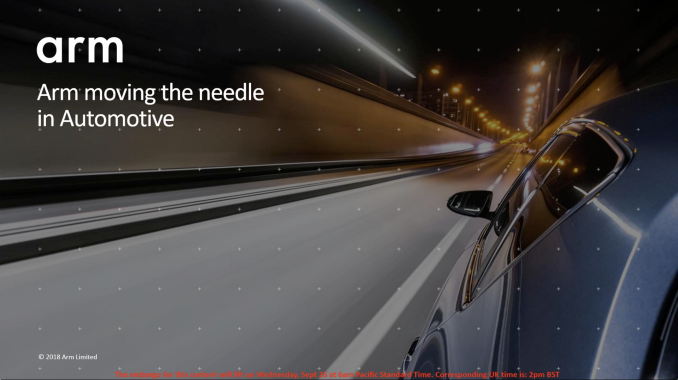
The market of automobiles is changing. Modern cars use more electronics than ever and adoption of electronic components in general and processors in particular is not going to slow down. All major automakers are working on self-driving vehicles, which means that cars of the future will need even more sophisticated SoCs.
As demand for components needed for autonomous cars is about to explode in the coming years, it is not surprising that more companies start to develop solutions specifically designed for such vehicles. Arm on Wednesday launched its new Arm Safety Ready Program that is aimed to develop solutions for self-driving cars. In addition, the company launched its Cortex-A76AE, its first processor IP designed specifically for autonomous vehicles.
Arm Safety Ready Program
Arm is clearly not a newcomer to the automotive market. The company’s general-purpose and real-time cores have been used by makers of various vehicles since 1996. Nowadays Arm’s IP is used for ADAS (collision avoidance, cruise control, etc.), connectivity, infotainment, powertrain control, and other components of the cars.
Meanwhile, up until lately Arm supplied automakers its IP originally developed for various devices in general. By contrast, the Arm Safety Ready Program is a multi-year program under which the company will develop Automotive Enhanced (AE) custom and semi-custom solutions for autonomous cars. Initially, Arm will start with solutions for Level 3 self-driving vehicles, but over time it will offer products built for Level 4 and Level 5 autonomous cars sometimes in 2020 and beyond.
The Arm Safety Ready Program spans the company’s entire portfolio of products and will include certified physical IP blocks to be made using specific process technologies, ISO 26262-certified software tools and components, safety documentation, and so on.
Right now, Arm only talks about its Cortex-A76AE processor for self-driving cars, but the grand plan includes Automotive Enhanced processors based on the Helios and the Hercules microarchitectures. Besides, Arm intends to offer AE versions of its future Cortex-R cores sometimes in 2020 and beyond. While Arm is developing AE flavors of its future IP, it will keep offering its existing cores (e.g., Cortex-A72, Cortex-R5, Cortex-R52, Cortex A53, Cortex-M4, Cortex-M7, Cortex-M44, etc.) to developers of SoCs for automotive market.
The implementation of the ASRP will enable makers of cars to obtain IP that will make their systems for autonomous driving significantly more energy efficient and cheaper, which will make self-driving vehicles more affordable in general. Besides making the said systems cheaper, Arm Safety Ready Program also promises to speed up their development.
Arm’s Cortex-A76AE: The First Member of the AE Family
The first product that is a part of Arm’s Safety Initiative is the company’s Cortex-A76AE processor with integrated redundancy. As the model number suggests, a Cortex-A76AE compute complex relies on up to 16 Cortex-A76 cores that support all the RAS (reliability, availability, serviceability) capabilities featured by the Arm v8.2 microarchitecture, and work in work in Split-Lock mode to ensure reliability.
Actual SoCs based on the Cortex-A76AE can scale to up to 64 cores. Besides general-purpose compute cores, Arm’s autonomous-class compute complexes also integrate Mali-G76 graphics cores, ARM’s ML cores, and other necessary IP. Besides, the complexes are set to support Arm’s memory virtualization and protection technologies required for flawless operation of ML and NN accelerators.
According to Arm, a 30-Watt 16-core Cortex-A76AE SoC implementation made using TSMC’s 7nm process technology has performance of over 250 KDMIPS, which is enough for today’s applications. If a customer wants a higher performance, it may build into more cores, or even use more than one SoC.
Raw performance is what actually matters for self-driving vehicles. Modern Level 3 autonomous cars run multiple programs at once and that is not going to change anytime soon. According to Arm, software for a Level 5 self-driving auto will contain 1 billion lines of code. By contrast, software used to run a Boeing 787 Dreamliner contains 14 million lines of code.
Arm’s Split-Lock: Redundant Computing in Hardware
Now, time to talk about the key feature of Arm’s Cortex-A76AE — the Split-Lock technology. The Split-Lock feature enables SoC developers to use the cores in two modes: the Split Mode to runs the cores independently and achieves higher performance, and in the Lock Mode a core is run in lockstep with a paired core, running the same code and monitoring for any kind of divergences that would be then reported as an error, and failure recovery mechanisms would take over (or at least a driver will be notified).
The Lock Mode somehow resembles how HP’s NonStop works for mission-critical applications, but the key difference is that Arm’s solution relies completely on hardware and is therefore compatible with any software (think AutoWare, Deepscale, Linaro, Linux, QNX, etc.).
Arm proposes to use the locked clusters for ASIL-D application that are critically important for safety. By contrast split clusters are intended for ASIL-B apps like infotainment. Given the flexibility of Arm’s hardware-only approach, the Split-Lock can be used by any automaker to run almost any software while ensuring either performance and error-free computing.


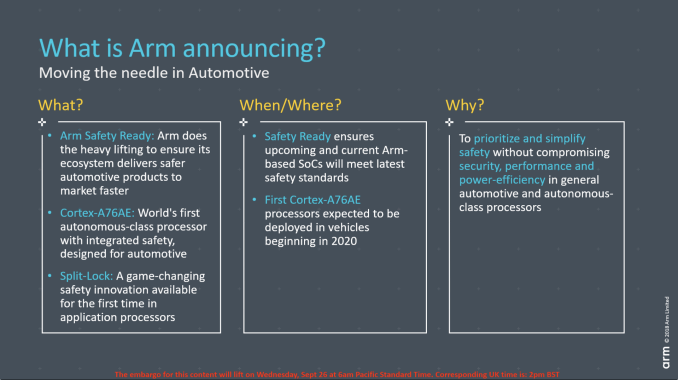
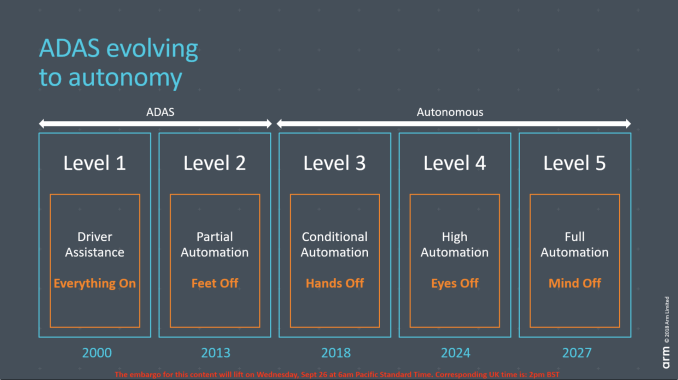

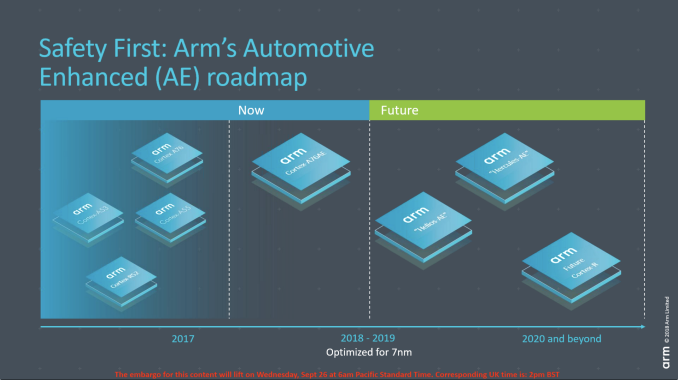
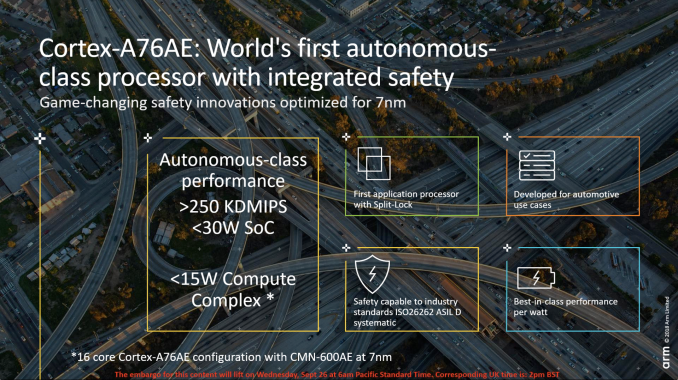
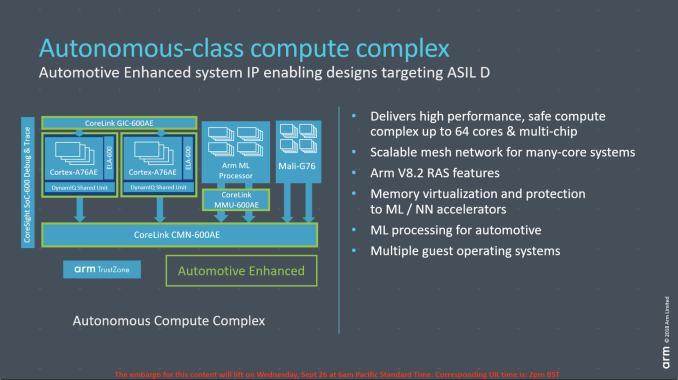

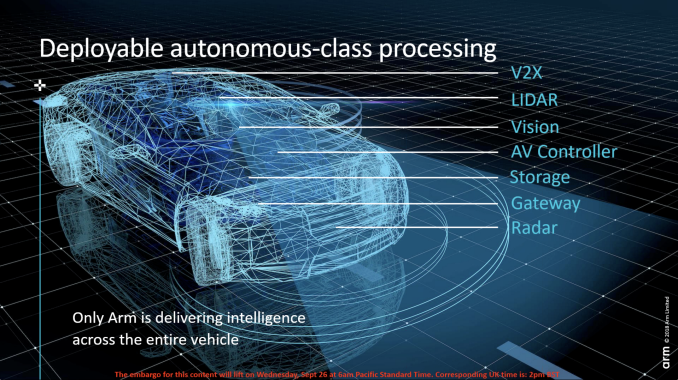














27 Comments
View All Comments
mooninite - Wednesday, September 26, 2018 - link
While this is interesting there is a flip side. The next car with this is going to total itself when it gets in a wreck with a legacy vehicle. The cost of all those radar systems and other electronic components is increasing the replacement costs when vehicles get into wrecks or are in natural disasters like a hurricane.Not only do we need to see advancements in these systems that they are advertising but there needs to be a little cost control embedded in there. However, I think car manufacturer greed will get the best of our wallets.
Kevin G - Wednesday, September 26, 2018 - link
Right now there are no cost controls because the price of the equipment is expense and generally custom. Advances are happening as manufacturers are starting to standardize and thus economies of scale will take effect. However, real mass production of these systems won't happen until the automotive gets the technology right. I do see this happening in my lifetime but the hype is out of control with some expecting fully autonomous vehicles in five years. Maturity will be a big thing, especially as insurers will have to account for this.Long term, things will be even more interesting as the we could start to see governments mandate autonomous vehicles. With all the cars on a collective network for travel, speed limits can be raised for good traffic/weather. While accidents will still happen (why hello there deer), communication of autonomous vehicles can adjust speeds and divert traffic so in aggregate travel will be faster. This is what companies are really chasing after, it isn't after solo autonomy but being the one that sets the standard with the patent portfolio that all other manufacturers have to license. That is where the really big money is long term.
boeush - Thursday, September 27, 2018 - link
The biggest benefit in the near term just might be autonomous, driverless big rigs rather than autonomous cars. Without drivers, big rigs could be easily pushed off peak hours, constrained to drive only, say, between 11 PM and 5 AM, and then between, 10 AM and 4 PM. Then everyone's commute would be vastly improved, because big rigs on the streets and highways/freeways are singlehandedly responsible for most of the slowdowns and gridlock. Yeah, truck drivers will be out of a job... I'll shed a tear for their plight, one of these days - I promise.HStewart - Wednesday, September 26, 2018 - link
It maybe just me but "autonomous" and "safety" just reminds me of the terminator.Death666Angel - Wednesday, September 26, 2018 - link
It's just you. You seem to be very "special" that way.HStewart - Wednesday, September 26, 2018 - link
I am not sure it just me - I dealt with computers a long time, but I am not sure I will trust them with all aspects of my life including driving. I originally thought this article is that ARM added some hardware changes to prevent spectrum style attack in there CPU.Fergy - Thursday, September 27, 2018 - link
Yeah it is really just you. Do you complain about the chips in the hospital as well? The chips that drive all the money systems?Is it just ARM you are afraid of? Or are IBM, AMD, Intel, Apple, Qualcomm, Samsung, Huawei safe?
V900 - Thursday, September 27, 2018 - link
I suspect, that folks like Fergy had a field day back in the late 40ies/early 50ies, mocking all the paranoid, anti-progress types who werent enthusiastic about nuclear bombs and nuclear energy."WHAT DO YOU MEAN YOU'RE WORRIED ABOUT NUCLEAR TESTS?!? You really think the government would have a nuke test site right outside Las Vegas if it was dangerous? What else are you scared of? Drinking fluoridated water?"
V900 - Thursday, September 27, 2018 - link
And nope, it would seem that HStewart isnt the only one to question the wisdom and benefits of self driving vehicles.In fact, outside of nerddom his opinion seems to be fairly mainstream:
https://mobile.reuters.com/article/amp/idUSKBN1FI0...
V900 - Thursday, September 27, 2018 - link
I wouldnt want it in my car either, but I'd go even further than you:A law forbidding self driving cars, both in personal vehicles but especially commercial vehicles, would be a great idea.
If you're a naive, white&middle class techno-utopianist in North America, selfdriving vehicles seem like "the future". But in reality, they will cause more problems than they solve.
Its not a future, its a dead end.